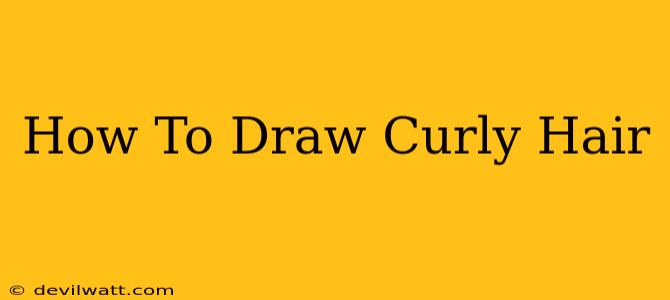Drawing curly hair can seem intimidating, but with the right techniques and a little practice, you can master it! This guide will walk you through various methods, from simple to more complex styles, helping you achieve realistic and expressive curly locks in your artwork. Whether you're a beginner picking up a pencil for the first time or an experienced artist looking to refine your skills, this comprehensive tutorial will provide valuable insights and tips.
Understanding the Structure of Curly Hair
Before you even pick up your pen or pencil, it's crucial to understand the unique characteristics of curly hair. Unlike straight hair, curly hair has a distinct S-shaped or spiral pattern. This curvature impacts how light reflects off the hair, creating highlights and shadows that are essential for achieving realism in your drawings. Understanding this fundamental aspect will greatly enhance the accuracy and lifelike quality of your artwork.
Key Characteristics to Observe:
- Curls' Shape and Size: Note the variety of curl sizes and shapes; some curls might be tight coils, others loose waves.
- Volume and Density: Curly hair often has more volume than straight hair. Pay attention to the thickness and density of the curls.
- Texture and definition: Observe the individual strands and how they clump together to form larger curls.
- Highlights and Shadows: The curvature of the hair creates interesting light and shadow patterns, which add depth and dimension.
Basic Techniques for Drawing Curly Hair
Let's start with some fundamental approaches suitable for beginners. These techniques will build a solid foundation for more advanced styles later on.
1. The "S" Curve Method:
This simple method focuses on drawing individual "S" curves to represent the curls. Start by sketching light, flowing "S" shapes, varying their size and direction to create a natural look. Gradually build up the density of the curls by layering more "S" shapes. Remember to leave gaps between curls to suggest volume and texture.
2. The Spiral Method:
For tighter curls, use the spiral method. Begin with a small circle or dot, then draw a spiral outwards, creating a coil-like effect. Repeat this process multiple times, varying the size and tightness of the spirals to achieve a realistic look.
Advanced Techniques: Adding Depth and Realism
Once you’ve mastered the basics, you can explore more advanced techniques to add depth, texture, and realism to your curly hair drawings.
1. Using Light and Shadow:
Mastering light and shadow is key to bringing your drawings to life. Observe how light falls on different parts of the hair, creating highlights and shadows. Use shading techniques (hatching, cross-hatching, blending) to create a three-dimensional effect. Pay particular attention to the areas where the curls overlap, creating deeper shadows.
2. Incorporating Texture:
To create a realistic texture, don't draw every single strand of hair. Instead, focus on suggesting the texture through variations in line weight, shading, and the spacing of your curls. Use a combination of light and dark lines to create the illusion of individual strands within the larger curls.
3. Defining Individual Strands:
For more detailed drawings, you can start adding individual strands to your curls. Use light, short, wispy lines to suggest the texture and movement of the hair. Don't overdo it; a few carefully placed strands can greatly enhance the realism of your drawing.
Different Curly Hair Styles
Practice drawing various curly hair styles to expand your skills:
- Afro: Focus on creating a dense, voluminous mass of tightly packed curls.
- Loose Waves: Use larger, less defined "S" curves.
- Bouncy Curls: Emphasize the roundness and volume of the curls.
- Braids and Twists: Integrate braids and twists into your drawings to add complexity and visual interest.
Tips for Success
- Use Reference Images: Observing real-life examples of curly hair will significantly improve your accuracy and understanding.
- Practice Regularly: Consistent practice is essential for developing your skills.
- Experiment with Different Mediums: Try different drawing tools, such as pencils, charcoal, or digital drawing software, to see which ones you prefer.
- Don't Be Afraid to Make Mistakes: Drawing is a process of learning and experimentation. Embrace your mistakes as learning opportunities.
By following these steps and practicing consistently, you will be well on your way to drawing stunning and realistic curly hair. Remember, patience and practice are key! So grab your pencils and start creating!

